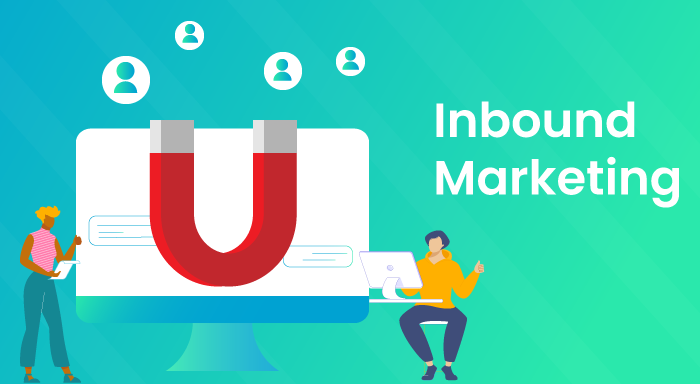Introduction
Inbound marketing is a customer-centric approach that helps a business to expand its reach and attract potential clients. This practice is more famous in B2B as compared to other business models. The reason being, this marketing strategy is subtle and sophisticated which is excellent for targeting executives and decision-makers. In this article, we are going to discuss key aspects like different strategies, planning, and implementation, benefits, etc.
If there is inbound marketing then there must be a thing called outbound marketing as well. So what is the key difference between both of them and why inbound is preferable, not outbound? Let’s have clear-cut inbound marketing vs outbound marketing face-off.
Inbound Marketing vs Outbound Marketing
Have you ever heard of pull marketing? In this style of marketing, the customer demand is increased by advertising a specific product or service. Inbound marketing uses many tactics that are part of pull promotional strategies like content marketing, organic traffic, SEO (Search Engine Optimization), social media, etc. The final objectives are to create brand awareness, increase reach, and attract new business. Inbound marketing lets potential customers find a business through various platforms like search engines, social media, etc. It means the ideal buyers automatically come to you, not the other way around.
On the contrary, in outbound marketing, a business seeks out customers. Some common practices of this marketing approach are door-to-door sales, trade shows, seminar series, outsourced telemarketing, advertising, and cold calling. Some common practices of this marketing approach are door-to-door sales, trade shows, seminar series, outsourced telemarketing, advertising, cold calling, or even as basic as reaching out to people and sharing your business cards with the QR codes. As you may have noticed, the initial investment of outbound marketing is higher compared to others, which also diminishes the final ROI (Return on Investment). Ironically, the surge of outbound marketing is the result of its doom. The more such techniques are implemented, the less effective they become. For example, the customer has found ways to block ads, cold calls, etc through spamming filters, caller IDs, and other means.
“68% of B2B customers prefer to do their own research before purchasing anything from anyone.”

In the outbound process, the sales reps or advertiser doesn’t have a complete idea of their audience, whereas, inbound campaigns are meticulously designed to target a specific set of audience. In inbound marketing people who found your website learn about your business through blogs, get informed, and show interest in your products, which also results in brand awareness.
What is Inbound Marketing?
The best way to inbound marketing is by quoting the inventor of this methodology- HubSpot. They say the inbound strategy is all about attracting customers via valuable content and then presenting them your products and later, providing the best possible service to customers.
When a customer finds something valuable, whether it’s on the internet or a physical place, the first thing they do is share it with other people. The same goes for the bad experience. If they get success from your business then it’s more likely that they recommend you to others. In this way, you can attract more prospective customers to your business, and this self-sustaining loop will go on till the end of the time.
The Sacred Inbound Marketing Funnel
The Inbound marketing funnel shows the journey of converting a lead into a promoter. Later, Hubspot made some modifications to this funnel and introduced a flywheel model. They usually prefer to call it “Inbound Marketing Flywheel”, whatever the name is, the monopoly of this funnel or flywheel lies in the utmost customer experience.
The funnel illustrates the entire process of converting a prospective customer to a lead, customer, and finally a promoter. This goal is achieved in four phases- Attract, Convert, Close, and Delight.
Let’s have a keen look at all four phases of arguably the best B2B marketing strategy.
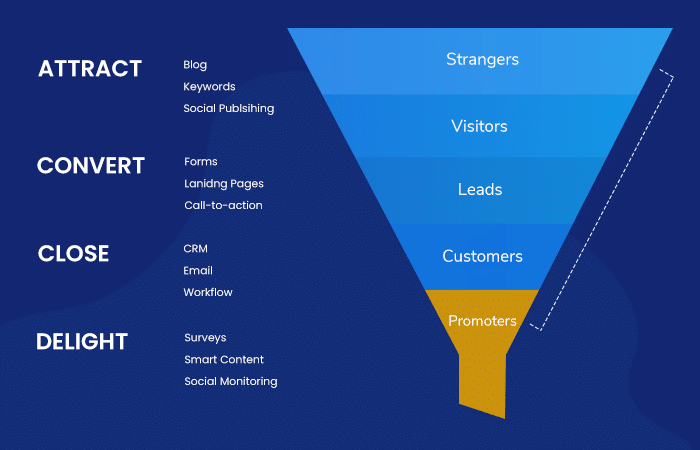
Attract
The buyer's persona has a vital role to play when it comes to attracting your potential customers. You can attract new potential customers to the company’s website, social media channels, or any other.
For this, you may need to generate high-quality and valuable content. One way to do this is to identify all the potential problems that your customers may be facing and show them how your products can solve those problems. Make sure to eliminate all kinds of irrelevant and redundant ads from your strategy.
Also, you should be aware of the ways through which customers may find you. In most cases, they search for you with the help of keywords, therefore, you should always know what people are looking for. In order to know this, you need to be at the top of your SEO game (Search Engine Optimization). For this, You can use tools such as Ahrefs and SEMrush to learn about the search intent. Both of them are great from an SEO as well as a content marketing perspective.
Convert
Suppose, you have managed to bring visitors to your website, Great! But now what? What are they supposed to do there?
Most businesses think their job is done as visitors start coming to the website. The website owner starts to presume that genuinely interesting visitors will fill up the contact form or ask for assistance upfront. But let us tell you this is no way near the truth.
This is exactly the opposite of what inbound marketing actually is. Leads won’t beg and ask for your services or products, you should approach them by the most appropriate means.
One such way to nurture website visitors is to provide them with useful and valuable content through blogs. In return, you can ask for their contact information. This is the simplest yet most effective way to convert a visitor into a lead.
Also, make sure to add an irresistible CTA- Call-to-action button to your blog post and website. Typically, a CTA lands the visitor on to contact form or landing page, you can do any of them as per your business type. We recommend you not start throwing sales pitches as soon as visitors sign up on your website. First, nurture them with ebooks, white papers, tips, etc. This will show your expertise to the visitors and this might increase your chances of doing business with them.
Close
Now you attracted some visitors and converted them into leads, but leads don’t pay bills or purchase products. A business is run because of its customers. Remember the job is only half done yet, if you want to be a star inbound marketer then you need to hammer down the last nail.
For a B2B company, leads know what they exactly want, so you can’t beat around the bush with them. Instead, show them your expertise, show them you know what you are talking about. Tell the leads how your products can help them in solving their problems.
You can use resources like product demonstrations, videos, documents, case studies, working manuals, etc. In this way, leads will realize that your company is the best for them. There are many lead-scoring solutions available that will present you with the most qualified and convertible leads of all.
Delight
Some might be wondering what else you can give to customers after they have purchased your products or services. For this, you first need to understand the contrast between a satisfied customer and a delighted customer.
A satisfied customer may purchase from you and start using your product or service. On the other hand, a delighted customer will not only purchase from you but also promote the products that they bought and loved. Once your customers are delighted with your services only then the inbound marketing funnel will be the ultimate success. Now, the question arises how do you delight your customers? Obviously, you can’t force them to promote your products. Here are some other options.
Provide an unmatched after-sales service.
>Understand the problems your customers are facing and resolve them as soon as possible.
>Never take a customer for granted.
>Show interest in your customers, their interests, and their business.
>The process is not instantaneous, which means, first you have to gain the confidence of your customers and focus on the ongoing customer relationship with dedication.
>These four parameters- Attract, Convert, Close, and Delight are the four fundamentals. However, inbound marketing allows you to be flexible and experimental unless you are not jeopardizing the customer experience.
Leading Experts Reveal the Secret Inbound Marketing Strategies
I am going to spill some secrets here, so follow on if you don’t want to miss out. These are the best inbound marketing strategies, with proven results. Let’s have a look at them.
1. Create Buyer’s Persona and Know your Customers
Did you ever notice that big successful companies always know what their customers want? They do that by creating buyer personas.
A buyer persona is an imaginary customer who represents the traits and characteristics of your targeted customers.
Other commonly used terms instead of buyer's persona are customer persona, audience persona, or marketing persona.
By creating a persona, you can make informed decisions related to customers, since you’ll already know their priorities.
But how will you create a buyer persona? Typically, a buyer persona includes tons of customer information like age, spending power, purchasing patterns, goals, pain points, etc.
If you don’t have time or resources to retrieve all this information, then there is an alternative that you can follow.
We are talking about analytic tools like Facebook Page Analytics or Google Analytics. Using any of these tools, you can learn more about your audience.
Facebook Page Analytics
Follow the steps mentioned below.
>Select the Facebook page. At the top, click on the button called Insights.
>On the left sidebar click on People.
>Here, you will see 3 tabs i.e. Your Fans, Your Followers, and People Reached.
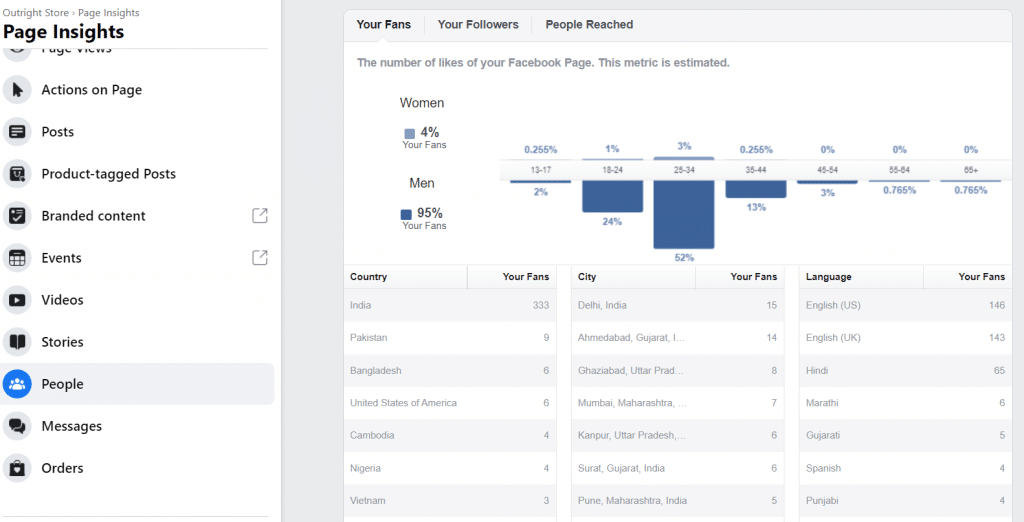
In each tab, you will get to see information about your audience, like their demographics, engagement, etc.
Google Analytics
Follow the steps mentioned below.
- Open Google Analytics. (Please make sure your website or app or whichever platform you’re using is connected to Google Analytics.)
- In the left-side navigation panel, there is an option called Audience. Upon clicking it, you will receive visitors/customers' information in abundance.
- You can see the demographics, interests, geolocation, devices, and much more.
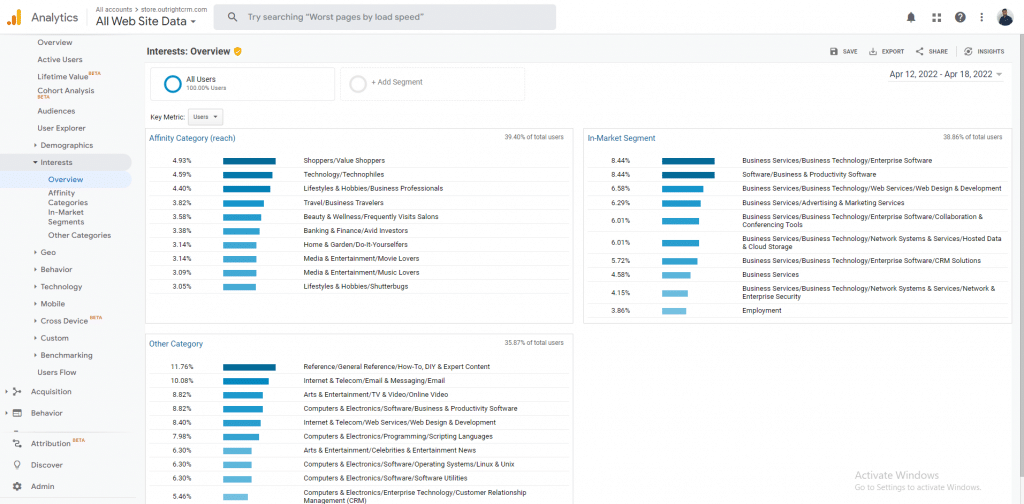
All this information is more than enough for creating an ideal buyer’s persona.
Tip: Use Google Search Console to learn about the search intent of the visitors.
2. Conduct a Survey for Customers and Leads
What else would be better other than asking the right questions directly from your customers and leads? And one thing ideal for this job is a survey.
Surveys are not only beneficial for businesses but for customers as well. Surveys make customers feel like they’re part of the community and their opinions matter as well.
You can use tools like SurveyMonkey or JotForm to simply run a survey for your audience. You can send it to emails or embed it on your website.
Tip: While creating the survey, please be subtle and ask the right questions only.
3. Influencer Marketing Campaign
Influencer marketing is a hot topic nowadays and major brands are leaning toward it. Do you know? 93% of marketers have already used influencer marketing and they are getting significantly amazing results.
Here is a secret, micro-influencer are playing a more important role as compared to mega-influencer with huge followings. The reason is that the audience of micro-influencers is more engaged. Because of this, smaller industries and startups are more likely to collaborate with micro-influencers.
One of the hardest parts of running an influencer marketing campaign is finding the right influencer. Make sure their targeted audience resonates with the idea of your products and services.
Tip: Go for the Micro-Influencers, they make sense in 2023
4. Write Data-Driven Articles
You should do extensive research about the content you are writing and that research should reflect in your content. Long-form research-based content generates more views and leads in comparison to short content. Try to make your content as helpful to the audience as possible. The more quality your content will have the more it will be shared.
Difference Between Inbound Marketing And Content Marketing
Inbound marketing and content marketing are used for similar purposes and have many similarities. But there are some subtle differences.
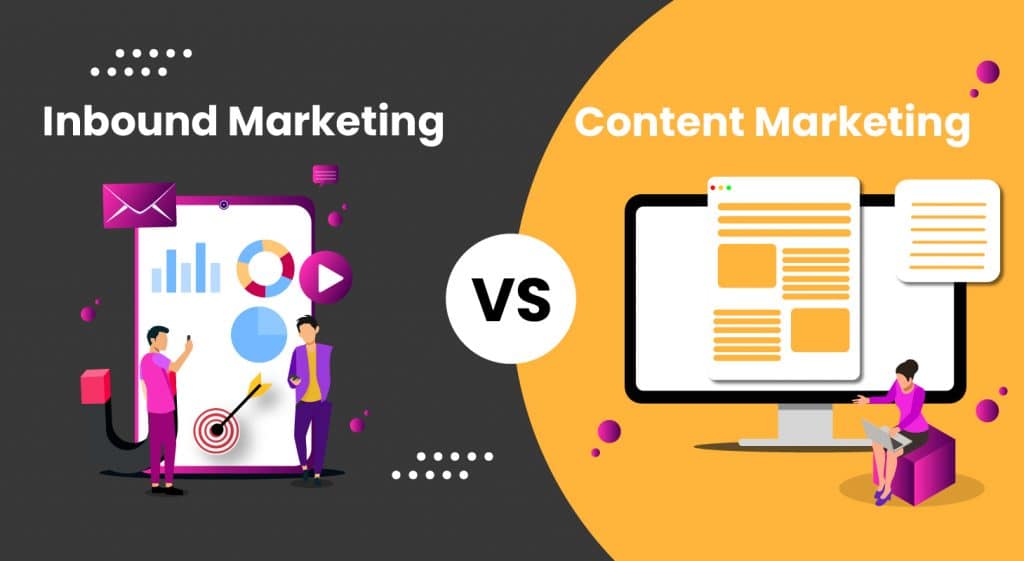
| Inbound Marketing | Content Marketing |
| The business methodology attracts the audience by creating valuable content for them and connecting to them through the content. It is particularly designed to solve people’s problems. | It is a marketing methodology of creating and distributing valuable content to the target audience in order to drive them toward the sales cycle. It is the further step of inbound marketing. |
| Its basic purpose is to attract an audience. | Its basic purpose is also to engage the audience along with attracting them |
| Examples include your brand's content on social media as social media is the best way to connect to people, creating SEO-optimized content for significantly solving people's specific problems, Ebooks and whitepapers, etc. | Examples include infographics, videos, and case studies to demonstrate your products and services, providing context and insights to your customers and leads. |
| It is a superset of content marketing. | It is a subset of inbound marketing. |
| Its metrics include lead generation, customer acquisition, retention, etc. | Its metrics include website traffic, engagement and shares, etc. |
In order to prosper in all fields businesses must understand the concept of both these methodologies and implement both for the appropriate scenarios and purposes. Content is king for business and businesses cannot master the field of content without understanding these methodologies. They both are more cost-effective than traditional marketing methods like advertisements and emails. They both contribute to increasing brand awareness. Both of these increase the lead generation.
How To Use Marketing Automation For Inbound Marketing?
Inbound marketing automation tools automate many processes of inbound marketing so that you can create relevant content without much workload.
- Inbound marketing automation is used to keep leads moving through a buyer's journey. They might not be ready for sale now but there are chances that they will revert to you for sale in the near future. So why miss any scope? You can also keep track of your leads through marketing automation applications.
- Marketing automation applications also have sales productivity tools that help the sales team to hit the leads at the right stage of the sales funnel.
- People have different preferences and choices even among the target audience there are many different choices and tastes of people. It is not possible for your marketing or sales team to analyze that. Hence marketing automation applications are required for that. Through marketing automation applications you can deliver the right content to them at the right time.
The first step is to get a SuiteCRM integrated into your system. There are many options available in the market like HubSpot, Salesforce, Omnisend, etc. You can choose any. Do research about the service provider. Study its features and functionalities and whether it provides them according to its price. Once you have selected the appropriate CRM then you have to integrate it and start the automation process. The three major areas of automation are- email marketing, social media marketing, and landing pages.
Challenges of Inbound Marketing
- Since inbound marketing focuses on specific problems therefore it has a minimal audience. It is viewed by people who have chosen to view it. It doesn't reach a mass audience which means it may be not very effective to increase your brand awareness.
- You cannot control who visits your content page and since people look for specific problems they will not also subscribe to your brand.
- Leads will not come towards the sales cycle because engagement is not the goal here and high chances are there that they might not be ready for sales hence it's difficult to determine ROI from it.
- There are chances of the spread of negative comments and bad reviews of products and services of a business.
Inbound Marketing Examples
The spectrum of inbound marketing examples is as wide as the number of potential ways to get visitors to your website. All of them include one basic element i.e. providing valuable and useful content.
Blogs
When it comes to blogging, quality with consistency is all that matters. Statistics suggest that 46% of readers take a blogger’s recommendations into consideration before making any purchase.I
f you publish blogs once after every 2 days then chances are your website traffic will increase by 3.5 times and the lead generation rate will increase by 4.5 times.

Through blogs, you can showcase your products and services, and answer the potential questions of your prospective customers. Nowadays, long-form content is quite popular, where readers are indulging themselves in research before making a purchase.
Due to this reason, in 2021 more than 80% of companies have adopted a dedicated content marketing strategy in order to reach the target audience.
Whitepaper
The concept of white papers is widely popular among B2B companies. White papers are a set of documents that comprise detailed and well-researched content but in a more formal manner as compared to blog posts.

White papers are specially designed and curated for products and services. Unlike blogs, in which you can talk about general topics. When a website visitor downloads a whitepaper then he/she will be expecting organized, informative, and in-depth content.
You can exchange these white papers for the contact information of the visitors. Later you can use the inbound marketing methodology to convert, close, and delight the customer.
Podcast
You might not notice but the popularity of podcasts has been increasing day by day. And why not? They are so accessible and easy to consume information. Just plug in the earphones and start listening. You don’t even need to look at the screen. You can multitask while listening to podcasts.

From the marketer’s perspective, podcasts allow you to connect with consumers on a personal level. It’s just like personally sharing information about your brand with each person.
Free Webinar
Host a free webinar that encourages customers to learn about your products and services. This is an extremely effective way as businesses and customers have interaction in real-time and hence customers can ask their queries and get an immediate response then and there only. This is a great way to generate many subscribers and people will get curious to know more about your brand.
Email Course
Free email courses offer useful information to leads hence you can provide an email course to your leads who are interested in knowing about your brand more. It is also cost effective hence at a low cost you can generate more subscribers. This process begins by sending your target audience an invitation to a masterclass and then sending them an invitation to an email course. This is a great way to generate many subscribers and leads.
The Final Words
Inbound marketing needs a unified effort from all departments like sales, marketing, customer service, and content marketing. The whole idea while implying this strategy is to keep the customer relationships at the center. For this purpose, you need powerful tools like CRM (Customer Relationship Management) software, a marketing automation platform, etc. We are pretty sure that after implementing this strategy, you will see a significant increase in your market share. And the good thing is that you'll retain these customers for a very long time.

